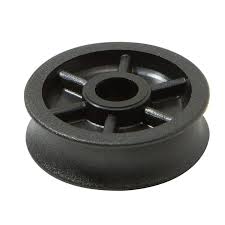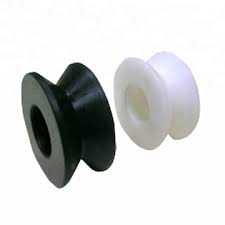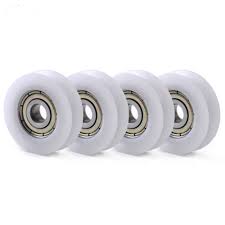Product Description
Product Name: Plastic flanged Ceramic pulley
| Place of Origin: | HangZhou China |
| Brand Name: | ZTF |
| Material: | 99% AL2O3 Ceramic, Plastic Cover or Alumina Cover |
| Application: | Wire Xihu (West Lake) Dis. |
| Polish: | Fine Polish degree Ra0.2 |
| Bearing: | High Speeding bearing |
| Hardness: | > HRA89 |
| Volume Density: | >3.88 |
| Color: | Black and pink |
| Molding Method: | LOW PRESSURE IN JECTION |
| Minimum Order Quantity: | 100 Pcs |
| Packaging Details: | Carton with foam |
| Delivery Time: | 3 days |
| Payment Terms: | T/T, Western Union, Money Gram, Paypal |
| Supply Ability: | 5,000,000pcs per month |
Detailed Product Description:
Plastic Flanged Ceramic Wire guide pulley is commonly used component when wire passing is required, it can be used in coil winding machine. cable machine and the textile machinery as well. The porcelain ring is mounted on the bearing. Coil winding wire guide pulley(wire roller) will rotate by the thread and wire passing on the surface of the ring. Thus the sliding friction has been converted to the static friction. But at the start and stop, in order to overcome the inertia. there will be a partial sliding friction. The surface polish degree of the porcelain ring reaches Ra0.2;the beating during rotation is under 0.15.We select the 99% AL2O3 as the material with the hardness of HRA88 and the density of 3.85.. Two nylon side walls have been put to the both side of the ceramic ring and the bearing, coil winding wire guide pulley (wire roller) combines 1 wire roller
| Modle No | A | B | C | D | E | Bearing No | Weight(g) | |
| HCR001 | -B03 | 20 | 15 | 3 | 4.8 | 3 | 623 | 3 |
| HCR002 | 28.4 | 20 | 6.4 | 4 | 7 | |||
| -B04 | 4 | 4*10 | ||||||
| -B05 | 5 | 5*10 | ||||||
| HCR003 | -B03 | 30.4 | 15 | 3 | 10 | 3 | 623 | 7 |
| HCR004 | -B04 | 40 | 20 | 4 | 15 | 3 | 694 | 12 |
| -B05 | 5 | 685 | ||||||
| -B07 | 7 | 677 | ||||||
| HCR045 | -B05 | 45 | 30 | 5 | 10 | 6 | 635 | 20 |
| -B06 | 6 | 626 | ||||||
| -B07 | 7 | 607 | ||||||
| -B08 | 8 | 698 | ||||||
| HCR005 | -B05 | 55 | 30 | 5 | 10 | 6 | 635 | 25 |
| -B06 | 6 | 626 | ||||||
| -B07 | 7 | 607 | ||||||
| -B08 | 8 | 698 | ||||||
| HCR006 | -B07 | 60 | 40 | 7 | 13 | 6 | 627 | 40 |
| -B08 | 8 | 608 | ||||||
| -B10 | 10 | 6900 | ||||||
| -B12 | 12 | 6901 | ||||||
| HCR007 | -B05 | 60 | 30 | 5 | 18 | 6 | 635 | 35 |
| -B06 | 6 | 626 | ||||||
| -B07 | 7 | 607 | ||||||
| -B08 | 8 | 698 | ||||||
| HCR008 | -B10 | 80 | 50 | 10 | 15 | 9 | 6200 | 95 |
| -B12 | 12 | 6001 | ||||||
| HCR009 | -B07 | 80 | 40 | 7 | 25 | 6 | 627 | 60 |
| -B08 | 8 | 608 | ||||||
| HCR571 | -B10 | 100 | 50 | 10 | 30 | 9 | 6200 | 120 |
Why Us:
- USD 1000 million sales every year;
- Excellent quality and Competitive price;
- Widely professional exporting experience all over the world;
- Well-trained and experienced staff will answer all your inquiries professional in any language;
- Good after-sales service offered.
- Culture
Culture:
We stick to the principle of the culture are Sustainability and Six High Standard: high-level management, high efficiency, high-qualified staffs, high-level skills, high-quality products, and high-speed developing sales. The best design includes consideration for the environment. That’s why we’re committed to making sure our processes, products, and people follow safe and environmentally-friendly practices. Other side, We prefer to bring the newest, most fashionable, high quality and healthiest products for our customer.
Service:
ZHENGTAIFENG METAL PRODUCT LIMITED products features complete presale, selling and after-sales service system, and provides detailed management and service for clients in terms of distribution channels. and provides professional and systematic advice for distributors.
Supplementary Service:
We have export license to assist our customers by handling export procedures. We have our team to control quality, arrange shipment, combine container (combine different kinds of items in 1 container from our factory to another). As we always care your thinking, we will be your professional partner to source your right products in China.
Suggestion:
Please kindly check the packages after you receive the goods, if you have any problem, please get in touch with us as soon as possible .
Contact us:
More products are available in ZHENGTAIFENG. They are all in competitive price and of good quality, just go to our company page to see the details.
If you find or not find the products you need, please have no hesitate to let us know.
FAQ:
| 1.Q:Are you a factory or trading company? |
| A:We are a professional manufacturer. Welcome to visit us, we’Il pick you up at GuangZhou airport or HangZhou airport. |
| 2.Q:Where is your factory located? |
| A:Our factory is located in HangZhou, ZheJiang Province, next to HangZhou. Warmly welcome domestic and foreign customers to visit! |
| 3.Q:How can I get a sample to test your quality? |
| A:Most samples are free except special products. New clients are expected to pay the courier. |
| 4.Q:How about your payment terms? |
| A:T/T in advence or one month after shipment |
| 5.Q:When can you deliver the goods? |
| A:If stock available, we can deliver it within 2 days. If not, that would be 5-7 working days after getting the deposit. |
| 6.Q:Does your company accept OEM or ODM production? |
| A:Yes, we are experienced in operating OEM & ODM, just send the detailed requirements. |
/* January 22, 2571 19:08:37 */!function(){function s(e,r){var a,o={};try{e&&e.split(“,”).forEach(function(e,t){e&&(a=e.match(/(.*?):(.*)$/))&&1
| Certification: | CE, ISO |
|---|---|
| Pulley Sizes: | Hcr001 |
| Manufacturing Process: | Casting |
| Samples: |
US$ 1.5/Piece
1 Piece(Min.Order) | Order Sample |
|---|
| Customization: |
Available
| Customized Request |
|---|
.shipping-cost-tm .tm-status-off{background: none;padding:0;color: #1470cc}
|
Shipping Cost:
Estimated freight per unit. |
about shipping cost and estimated delivery time. |
|---|
| Payment Method: |
|
|---|---|
|
Initial Payment Full Payment |
| Currency: | US$ |
|---|
| Return&refunds: | You can apply for a refund up to 30 days after receipt of the products. |
|---|
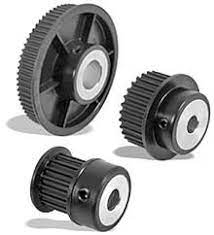
How are plastic pulleys used in material handling and packaging machinery?
Plastic pulleys play a crucial role in material handling and packaging machinery. Here’s a detailed explanation:
1. Conveyor Systems:
In material handling applications, plastic pulleys are commonly used in conveyor systems. Conveyor belts are driven by pulleys, and plastic pulleys are favored for their lightweight yet durable construction. Plastic pulleys provide smooth and reliable power transmission, ensuring efficient movement of materials along the conveyor belt. They are resistant to corrosion, which is particularly advantageous in environments where moisture or chemicals may be present.
2. Tensioning and Tracking:
Plastic pulleys are utilized for tensioning and tracking purposes in material handling machinery. Tensioning pulleys help maintain the appropriate tension of belts or chains in conveyor systems, preventing slippage and ensuring consistent movement. Plastic pulleys are often equipped with built-in bearings or bushings, facilitating easy rotation and adjustment. Additionally, plastic pulleys with tracking grooves or flanges are used to keep belts aligned and centered, minimizing the risk of misalignment or product damage.
3. Packaging Machinery:
In packaging machinery, plastic pulleys are employed in various applications. They are frequently used in equipment such as wrapping machines, carton sealers, labeling machines, and case packers. Plastic pulleys assist in the smooth movement and positioning of packaging materials, ensuring precise and efficient packaging operations. Their lightweight nature minimizes the load on the machinery, allowing for faster acceleration and deceleration during packaging processes.
4. Bottle and Container Handling:
Plastic pulleys find extensive use in bottle and container handling systems. These systems are responsible for transferring bottles or containers from one location to another, such as filling stations, capping machines, or labeling stations. Plastic pulleys with specific designs, such as grooves or teeth, enable secure grip and smooth transfer of bottles or containers, preventing slippage or damage. They are also resistant to chemical substances commonly found in the packaging industry.
5. Rotary Tables and Indexers:
Rotary tables and indexers are commonly used in material handling and packaging machinery to control the precise movement and positioning of products. Plastic pulleys are utilized in these systems to provide smooth and accurate rotation or indexing. They contribute to the precise alignment of workpieces or products, ensuring reliable and consistent performance. Plastic pulleys with low friction properties enhance the efficiency of rotary tables and indexers, reducing power consumption and wear.
6. Automated Guided Vehicles (AGVs):
AGVs are autonomous mobile robots used for material handling applications within warehouses or manufacturing facilities. Plastic pulleys are often incorporated into the drive systems of AGVs to facilitate smooth movement and steering. These pulleys contribute to the accuracy and reliability of AGV navigation, enabling efficient transportation of materials or products. Additionally, plastic pulleys are lightweight, which helps optimize the payload capacity and energy efficiency of AGVs.
7. Ergonomic Handling Equipment:
Plastic pulleys are utilized in ergonomic handling equipment, such as lift-assist devices or ergonomic conveyors. These systems are designed to reduce the physical strain on operators during material handling tasks. Plastic pulleys enable smooth and effortless movement of loads, enhancing operator comfort and productivity. Their lightweight construction makes them suitable for portable or adjustable equipment, allowing for versatile and user-friendly handling solutions.
In summary, plastic pulleys are integral components in material handling and packaging machinery. Their versatility, lightweight construction, durability, and resistance to corrosion and chemicals make them well-suited for various applications in these industries. Plastic pulleys contribute to the efficiency, reliability, and smooth operation of machinery, ultimately enhancing productivity and ensuring accurate handling and packaging of materials and products.
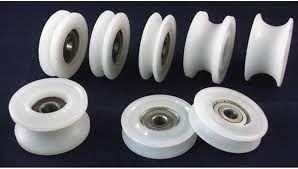
What safety considerations should be kept in mind when using plastic pulleys?
When using plastic pulleys, several safety considerations should be kept in mind to ensure the well-being of operators and the proper functioning of machinery or equipment. Here’s a detailed explanation:
1. Load Capacity:
One important safety consideration is to ensure that the plastic pulleys are selected and designed to handle the anticipated loads and forces in the application. Exceeding the load capacity of the pulleys can lead to premature failure, belt or chain slippage, or even catastrophic accidents. It is essential to consult the manufacturer’s specifications and guidelines to determine the maximum load capacity of the plastic pulleys and ensure they are not overloaded.
2. Material Compatibility:
Consider the compatibility of the plastic pulley material with the surrounding environment and the materials it comes into contact with. Some chemicals, solvents, or extreme temperatures may adversely affect certain types of plastic. Ensure that the chosen plastic material is resistant to the specific chemicals or conditions present in the application to avoid material degradation, weakening, or failure of the pulleys.
3. Proper Installation:
Correct installation of plastic pulleys is crucial for safety. Follow the manufacturer’s instructions and guidelines for proper pulley installation, including mounting options, alignment, and fastening mechanisms. Improperly installed pulleys can lead to misalignment, belt or chain disengagement, excessive vibrations, or other operational issues that compromise safety. Ensure that pulleys are securely attached and aligned to prevent accidents or damage to the machinery or equipment.
4. Guarding and Enclosures:
Consider incorporating appropriate guarding and enclosures around the plastic pulleys to prevent accidental contact with moving parts. This is especially important in conveyor systems or machinery where operators or maintenance personnel may need to interact with the pulleys. Guards and enclosures help prevent injury caused by entanglement, pinching, or getting caught in the rotating components, enhancing overall safety in the work environment.
5. Regular Inspection and Maintenance:
Regular inspection and maintenance of plastic pulleys are essential for identifying any signs of wear, damage, or degradation. Inspect the pulleys periodically to check for cracks, excessive wear, or any other visible issues. Replace any damaged or worn-out pulleys promptly to avoid unexpected failures or accidents. Additionally, follow the manufacturer’s recommendations for lubrication, cleaning, or any other maintenance procedures to ensure the pulleys function optimally and safely.
6. Training and Awareness:
Proper training and awareness among operators and maintenance personnel are essential for safe operation and handling of machinery or equipment with plastic pulleys. Ensure that personnel are trained on the correct procedures for operating, maintaining, and troubleshooting the equipment. They should be aware of the potential hazards associated with plastic pulleys and understand the safety protocols to follow, including lockout/tagout procedures, emergency stop mechanisms, and personal protective equipment requirements.
7. Compliance with Regulations:
Ensure that the use of plastic pulleys complies with relevant safety regulations, standards, and guidelines specific to the industry or region. Different industries may have specific requirements for safety, such as those related to food processing, hazardous environments, or machinery certification. Adhering to these regulations helps ensure that the plastic pulleys and associated machinery or equipment meet the necessary safety standards.
By considering these safety considerations when using plastic pulleys, operators can minimize risks, prevent accidents, and ensure the safe and efficient operation of machinery or equipment in various industrial applications.
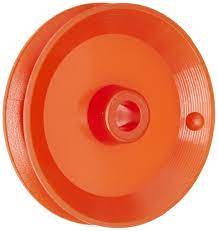
What types of belts or cables are typically employed with plastic pulleys?
Plastic pulleys are designed to work in conjunction with different types of belts or cables, depending on the specific application and requirements. Here’s a detailed explanation of the types of belts or cables that are typically employed with plastic pulleys:
1. Timing Belts:
Timing belts, also known as synchronous belts, are commonly used with plastic pulleys. Timing belts have evenly spaced teeth on the inner surface, which engage with corresponding teeth on the plastic pulleys. This toothed design allows for precise power transmission and synchronized movement in applications that require accurate positioning or timing, such as in automotive engines or industrial machinery.
2. V-Belts:
V-belts, also called Vee belts, are frequently employed with plastic pulleys. V-belts have a trapezoidal cross-section and rely on friction between the belt and the pulley groove to transmit power. The angled sides of the V-belt fit into the corresponding V-shaped grooves on the plastic pulleys, providing reliable power transfer. V-belts are commonly used in applications such as HVAC systems, industrial machinery, and automotive accessory drives.
3. Flat Belts:
Flat belts, as the name suggests, have a flat surface and are often used with plastic pulleys. They rely on friction between the belt and the pulley surface to transmit power. Flat belts are versatile and find applications in various industries, including packaging machinery, material handling systems, and printing presses. Plastic pulleys with a flat surface are designed to provide optimal grip and traction for effective power transmission with flat belts.
4. Round Belts:
Round belts, also known as round o-ring belts or endless belts, are circular belts without any visible seam or splice. They are commonly utilized with plastic pulleys that have rounded grooves or flanges. Round belts are flexible and can be easily threaded through a system of pulleys, making them suitable for applications such as conveyor systems, packaging machinery, and small appliances.
5. Cable Systems:
Plastic pulleys are also employed with various types of cables in certain applications. Cable systems, such as wire rope or cables with an outer protective coating, may be guided or routed through plastic pulleys to achieve controlled movement or tensioning. These cable systems find applications in industries such as construction, material handling, and transportation.
6. Other Specialty Belts:
In addition to the commonly used belts mentioned above, plastic pulleys can be employed with other specialty belts based on specific requirements. For example, polyurethane belts, round tooth belts, or specialty conveyor belts may be used in applications where higher load capacity, chemical resistance, or specialized functionality is needed.
In summary, plastic pulleys can be paired with various types of belts or cables, including timing belts, V-belts, flat belts, round belts, cable systems, and other specialty belts. The choice of belt or cable depends on factors such as the application, power transmission requirements, desired accuracy, and environmental conditions. Plastic pulleys are designed to provide optimal engagement, grip, and traction for the specific type of belt or cable, ensuring efficient and reliable power transmission in a wide range of industries and applications.


editor by CX
2024-05-06

